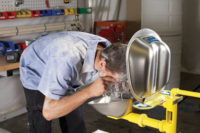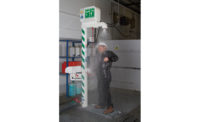But what about other workplaces? Should your company have these facilities available? OSHA offers some guidance in its section on Medical Service and First Aid, 1910.151, which says:
"Where the eyes or body of any person may be exposed to injurious corrosive materials, suitable facilities for quick drenching or flushing of the eyes and body shall be provided within the work area for immediate emergency use."
Know your stuff
The best advice is to know your workplace. Check the following items when considering use of emergency showers and/or eye wash stations:1) Corrosives. Do you have any corrosives? These could be an acid or an alkaline. Corrosives are chemicals that do irreversible damage to living tissue. They can scar skin, including the face, and damage eyes. Whatever damage is done, until the corrosive is washed out with water, is permanent.
An irritant, on the other hand, may temporarily burn the skin or eyes, and you'll want to wash it out, but unlike corrosives the damage is not permanent.
2) Maintenance shop. How many and what size batteries are charged there? OSHA inspectors will evaluate this area and determine whether eye wash/emergency showers are needed. If they decide you should have them and you do not, you'll probably receive a fine, depending on the amount and type of personal protection is provided.
Where the possible exposure is low, OSHA will allow you to use an "identified" water hose fitted with a face and body wash nozzle. The water hose must be pressure-controlled and able to deliver large amounts of water. "Identified" means marked and not used for anything else.
Where personal protection is used, a mounted portable eye wash device containing not less than one gallon of water is considered minimum employee protection.
3) Boiler chemicals. Most are corrosive and are used and stored in and dispensed out of large drums. Therefore, all our boiler rooms have emergency showers/eye washes in them.
4) Cleaning products. Know what cleaners your custodian uses. These usually would require proper eye protection. If a strong cleaner is dispensed from a larger container, you might need an eye wash there as well. Or you could simply change cleaners.
How do you choose?
Once you decide you need an emergency eye wash/shower, what type is best suited for your facility? There are many varieties to choose from. Consider your uses and operations, your needs and applications.1) Do you need a shower on a dock where you off-load bulk chemicals? If so, you might need heated water supplied to it if temperatures get below freezing in the winter. Devices that regulate water temps are available.
2) Do you have remote work sites or mobile crews where there is no piped water? If yes, then a portable unit made for emergency use is your only option.
3) Is the storage and chemical use at your plant continuous and static? If it is, then you need piped water and not a portable unit. Even though some portables can deliver .42gpm for 15 minutes, sometimes 15 minutes isn't enough. For this reason, when you use a portable eye wash always have a backup option.
4) Do you have people working in wheel chairs? Barrier-free shower and eye wash stations are available.
5) Are any of the chemicals you use so exotic that even a mixture of them with water cannot go down the drain? Better invest in a rinse water containment pool.
Getting ready to install
Before you order your eye wash/shower, contact the maintenance department. They will tell you whether you need a floor- or wall-mounted unit. They will also probably not be thrilled with your decision to install such an apparatus. The real expense of eye washes/safety showers is not their direct cost, but the cost of running water to them. Sometimes this might involve jack-hammering up a concrete floor. There's also the question of available floor drains.After conferring with maintenance, you might decide that it's easier to shift the chemical use or storage areas than to renovate the plant. In any case, never compromise the safety of your employees.
The current ANSI Standard ANSI Z358.1 requires testing for the pattern, volume and temperature of the water, just to name a few. ANSI calls for weekly inspections and alarms. Whether you follow the ANSI Standard or not, someone needs to make sure that the emergency eye wash/shower is always in working order.
Put yourself in users' shoes
When providing eye washes/showers, place yourself in the situation of someone who needs to use one. Picture someone who is not just experiencing a burning sensation to the eyes, face or body, but who is in severe pain.
Make sure a person in that condition can easily access and operate the wash station. Position it where they would not likely have to go through a door or across the plant with stabbing pain in their eye to find it. And remember, if the only thing that brings physical relief is a flow of cool water, don't make the flow end after 15 minutes.
SIDEBAR: Eye wash/shower training tips
If you have corrosives, training for using an emergency eye wash/shower can easily be incorporated into Hazard Communication Training. Tell your people that they need to:
- Hold their eyes open with their fingers when washing their eyes out.
- Wash from the inside corner of the eye out rather than vise versa.
- Disrobe in order to do a proper job of drenching their bodies.
- Wash small splashes off their hands or feet as soon as possible.

